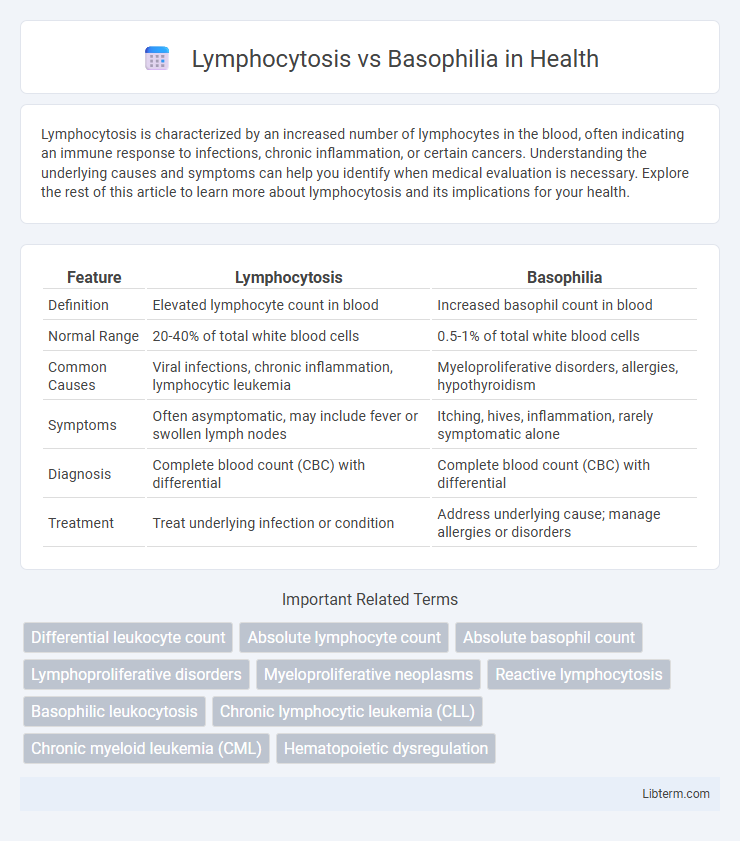Lymphocytosis is characterized by an increased number of lymphocytes in the blood, often indicating an immune response to infections, chronic inflammation, or certain cancers. Understanding the underlying causes and symptoms can help you identify when medical evaluation is necessary. Explore the rest of this article to learn more about lymphocytosis and its implications for your health.
Table of Comparison
| Feature | Lymphocytosis | Basophilia |
|---|---|---|
| Definition | Elevated lymphocyte count in blood | Increased basophil count in blood |
| Normal Range | 20-40% of total white blood cells | 0.5-1% of total white blood cells |
| Common Causes | Viral infections, chronic inflammation, lymphocytic leukemia | Myeloproliferative disorders, allergies, hypothyroidism |
| Symptoms | Often asymptomatic, may include fever or swollen lymph nodes | Itching, hives, inflammation, rarely symptomatic alone |
| Diagnosis | Complete blood count (CBC) with differential | Complete blood count (CBC) with differential |
| Treatment | Treat underlying infection or condition | Address underlying cause; manage allergies or disorders |
Overview of Lymphocytosis
Lymphocytosis is characterized by an elevated lymphocyte count in the blood, often exceeding 4,000 cells per microliter, and typically indicates viral infections, chronic inflammatory conditions, or certain hematologic malignancies like chronic lymphocytic leukemia. It involves an increase in B cells, T cells, or natural killer cells, which play crucial roles in immune response and antibody production. Unlike basophilia, which specifically involves a rise in basophil granulocytes often linked to allergic reactions or myeloproliferative disorders, lymphocytosis reflects broader immune system activation primarily driven by lymphocyte proliferation.
Overview of Basophilia
Basophilia is characterized by an elevated number of basophils in the blood, often exceeding 200 cells per microliter, and is primarily associated with allergic reactions, chronic inflammation, and certain myeloproliferative disorders such as chronic myeloid leukemia (CML). Basophils play a critical role in immune response by releasing histamine, heparin, and other mediators that contribute to inflammation and hypersensitivity. Unlike lymphocytosis, which involves increased lymphocytes related to viral infections or immune activation, basophilia specifically signals conditions involving mast cell activation or hematologic malignancies.
Causes of Lymphocytosis
Lymphocytosis primarily results from viral infections such as Epstein-Barr virus, cytomegalovirus, or hepatitis, and can also arise due to chronic lymphocytic leukemia or autoimmune disorders like rheumatoid arthritis. It is characterized by an increased absolute lymphocyte count exceeding 4,000 cells/uL in adults. Unlike basophilia, which is commonly associated with myeloproliferative disorders and allergic reactions, lymphocytosis reflects immune system activation predominantly in response to infectious or inflammatory stimuli.
Causes of Basophilia
Basophilia primarily results from chronic inflammation, allergic reactions, myeloproliferative disorders such as chronic myeloid leukemia, and certain infections like tuberculosis. Elevated basophil counts also occur in hypothyroidism, ulcerative colitis, and during recovery from anaphylaxis. Unlike lymphocytosis, which often indicates viral infections or lymphoid malignancies, basophilia signals immune system activation linked to histamine release and mast cell stimulation.
Key Differences: Lymphocytosis vs Basophilia
Lymphocytosis is characterized by an elevated lymphocyte count often linked to viral infections, chronic inflammation, or certain leukemias, whereas basophilia involves an increased basophil count typically associated with allergic reactions, chronic myeloproliferative disorders, or hypothyroidism. Lymphocytosis primarily indicates immune response to viral or persistent antigenic stimuli, while basophilia reflects hypersensitivity responses or myeloproliferative activity. Differentiating these conditions requires comprehensive blood counts and clinical correlation with patient history and symptoms for accurate diagnosis and management.
Diagnostic Approaches for Evaluation
Diagnostic approaches for lymphocytosis prioritize complete blood count (CBC) with differential to quantify lymphocyte levels, followed by flow cytometry to identify clonal populations suggestive of lymphoproliferative disorders. Evaluation of basophilia involves CBC with differential to determine elevated basophil counts, bone marrow biopsy for assessing myeloproliferative neoplasms, and molecular testing for mutations such as BCR-ABL1 in chronic myeloid leukemia. Both conditions require thorough patient history, peripheral smear examination, and targeted laboratory assessments to distinguish reactive causes from malignant etiologies.
Associated Diseases and Conditions
Lymphocytosis commonly occurs in viral infections such as infectious mononucleosis, chronic lymphocytic leukemia, and certain autoimmune disorders like rheumatoid arthritis. Basophilia is often associated with myeloproliferative disorders including chronic myeloid leukemia, Hodgkin's lymphoma, and hypersensitivity reactions such as allergic dermatitis. Both conditions reflect distinct hematologic and immunologic responses, aiding diagnosis of underlying diseases.
Clinical Manifestations and Symptoms
Lymphocytosis presents clinically with symptoms such as persistent fever, fatigue, and swollen lymph nodes, often indicating viral infections or certain hematologic disorders. Basophilia typically manifests with symptoms including itching, flushing, and abdominal discomfort, frequently associated with myeloproliferative diseases like chronic myeloid leukemia. Both conditions require differential diagnosis through complete blood count and bone marrow analysis to determine the underlying cause.
Treatment Strategies and Management
Treatment strategies for lymphocytosis primarily target underlying infections, chronic inflammatory conditions, or hematologic malignancies, often involving antiviral therapies, corticosteroids, or chemotherapy depending on the etiology. Basophilia management focuses on addressing causes such as myeloproliferative disorders, allergic reactions, or chronic inflammation, with therapies including antihistamines, corticosteroids, and targeted treatments like tyrosine kinase inhibitors in cases of chronic myeloid leukemia. Regular monitoring of blood counts and disease progression is essential for both conditions to tailor treatment plans and prevent complications.
Prognosis and Clinical Significance
Lymphocytosis indicates an increased lymphocyte count often associated with viral infections, chronic inflammatory conditions, or certain leukemias, usually suggesting a reactive or benign prognosis depending on the underlying cause. Basophilia, characterized by an elevated basophil count, frequently points to myeloproliferative disorders such as chronic myeloid leukemia and tends to have a more guarded prognosis due to its link with hematologic malignancies. Both conditions require thorough clinical evaluation, bone marrow examination, and molecular studies for accurate diagnosis and tailored management.
Lymphocytosis Infographic

 libterm.com
libterm.com